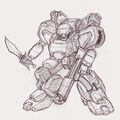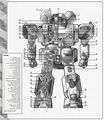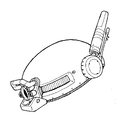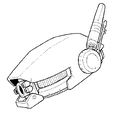Hunter
The Hunter was the North's first Heavy Gear ever produced for the purpose of warfare. Prior to the Hunter, most combat-ready heavy gears were made by rigging construction gears with weapons. The Hunter is still in use today as the "Mark II", with the original design having gone through several generations of upgrades.
Shortly after its conception, the designs were stolen by agents of the Southern Alliance and were used to produce the Jager.
History
BOT-Project
The beginning of the Hunter began when the UMF overhauling of many of their other military systems. The UMF Army's Joint Military Development Committee issued a call for tenders concerning a BOT (Bipedal One-man Tank) unit, an evolution of the refitted Hard Hat units Terra Nova had been using to wage war. This unit was slated to be the first ever military combat walker vehicle. The commitee was influenced by the rising aggression of southerners and the more progressive elements within the army that advocated for the use of walker vehicles for combat.
The Hunter was the first exclusively military walker machine on Terra Nova and remains among the most commonly seen Gear designs in active military service. Its greatest strength has always been its versatility and simplicity of design. Created when there were no scout/recon or fire-support Gears, the Hunter had to manage all by itself or in conjunction with more traditional armored or infantry forces.
Although a great challenge to create, the Hunter was designed to be relatively easy to maintain and upgrade, allowing it to remain in service for decades without being refit. The simplicity of design has also meant a proliferation of specialized variants designed to excel at specific combat tasks. The standard Hunter (actually the Mark II, introduced in TN 1852) remain in wide usage, however, even in the face of more advanced machines. The standard armament of the Hunter reflects its generalized military duty.
A Riley M222 autocannon rifle and a RP-109 Pepperbox act as the primary weapons, providing a good combination of firepower, range and limited indirect fire capabilities. A Mark IV anti-personnel grenade launcher provides additional defense against infantry, while several Gear-scale M-2A hand grenades and a vibroknife allow the Hunter to enter close combat.
Advanced Technology Overhaul
Since the War of the Alliance, a general updating of Northern military Gears began early TN 1933. the Advanced Technology Overhaul (ATO) program has seen most Northern Gears undergo very minor modifications in an effort to standardize production. The only obvious external change has been the introduction of a square-helmet design for the armor plates on the sensor head. This design dates back to the Headhunter, but has now become standard for the Hunter, Cheetah and Jaguar families. Aside from its production advantages, it removes the necessity for padded crash-bars.
Usage
The Hunter is the most common gear found in Northern forces partly due to it's rugged build and flexibility as well as it's low production cost. The Hunter can be equipped with a variety of weapons ranging from autocannons to bazookas. The hunter is most commonly found in General Purpose squads, but is also commonly placed in Fire Support squads, Dragoon Squads, and Strike Squads. Specific Squad designation depends on weapon loadout. If equipped with paratrooper equipment, Hunters can be placed in Paratrooper Squads as well.
While the Hunter is viewed as a flexible military asset, its main role on the battlefield is support regardless of weapon loadout. The Hunter is easily outclassed by heavier, more specialized gears, yet can hold it's own when it benefits from numerical superiority and equipped properly to handle their intended target.
The Hunter has seen more action than any other Northern combat Gear. First deployed during border conflicts between the expansionist United Mercantile Federation and the other major Northern leagues, the Hunter encountered its Southern counterpart (the Jäger) during the Merchant War of TN 1686 to 1688. The devastating battles of St. Vincent’s War were also fought by the Hunter and the wide-scale warfare saw the machine begin to spread into the Badlands.
The Gear was modernized and renamed the Hunter Mark II in the TN 1850s during another period of intense North-South conflict. The hard times of the War of the Alliance proved the endurance of the Hunter, because expensive spare parts and complex repair procedures limited the availability and service of more sophisticated machines.
Northco is currently examining the possibility of creating a Hunter Mark III.
Variants
- Stripped-Down Hunter
- Para Hunter
- Spearhead Hunter
- Hunter Zerstorer
- Hunter Commando
- Armored Hunter
- Bearhunter
- Hunter XMG
- Night Hunter
- Hunter MP
Media
External links
- Hunter miniature | DP9 online store
- Hunter miniature (two pack) | DP9 online store
- Hunter XMG miniature | DP9 online store
| Units | |||||||||||||||||||||||||||||||||||||||||||||||||||||||||||||
|---|---|---|---|---|---|---|---|---|---|---|---|---|---|---|---|---|---|---|---|---|---|---|---|---|---|---|---|---|---|---|---|---|---|---|---|---|---|---|---|---|---|---|---|---|---|---|---|---|---|---|---|---|---|---|---|---|---|---|---|---|---|
| Terra Nova |
| ||||||||||||||||||||||||||||||||||||||||||||||||||||||||||||
| Earth |
| ||||||||||||||||||||||||||||||||||||||||||||||||||||||||||||
| Caprice |
| ||||||||||||||||||||||||||||||||||||||||||||||||||||||||||||
| Utopia |
| ||||||||||||||||||||||||||||||||||||||||||||||||||||||||||||
| Eden |
| ||||||||||||||||||||||||||||||||||||||||||||||||||||||||||||








